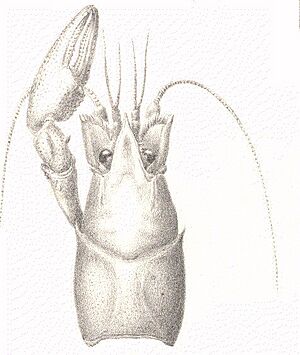Acuminate crayfish facts for kids
Quick facts for kids Acuminate crayfish |
|
|---|---|
 |
|
| Conservation status | |
| Scientific classification | |
| Genus: |
Cambarus
|
| Species: |
acuminatus
|
The Cambarus acuminatus, also known as the acuminate crayfish, is a type of freshwater crayfish that lives in rivers and streams. It belongs to the Cambaridae family, which is a group of crayfish found mostly in North America. These interesting creatures are an important part of their underwater homes.
Contents
Discovering the Acuminate Crayfish
The acuminate crayfish was first officially described in 1884 by a scientist named Walter Faxon. He was a curator at the Museum of Comparative Zoology at Harvard University. Faxon studied crayfish specimens that were collected in 1877 from the Saluda River in South Carolina. These specimens were found by David Starr Jordan, a fish expert (called an ichthyologist), and his student, Alembert Brayton.
When Faxon first described this crayfish, his notes were quite short and didn't include any pictures. This was common for scientists at that time. Unfortunately, the original crayfish specimens he used have since been lost.
Scientists have noticed that different groups of acuminate crayfish look a bit different from each other. This suggests that what we call C. acuminatus might actually be a group of very similar species, known as a "species complex." Because the original description was brief and the first specimens are gone, it's been tricky for scientists to tell these similar species apart. To help with this, new specimens of C. acuminatus have been collected from the Saluda River, very close to where the original ones were found.
What Does It Look Like?
The acuminate crayfish has a body color that can range from red-brown to orange-brown. These crayfish are fairly small. They usually measure between 13.3 and 21.0 millimeters long. That's about half an inch to almost an inch!
Where Does It Live?
The acuminate crayfish complex lives across a wide area in eastern North America. You can find them from Columbia, South Carolina, all the way north to southeastern Pennsylvania. This area includes much of the Piedmont Plateau and the Gulf Coastal Plain.
However, the specific C. acuminatus (the one described from the new specimens) seems to live only in the Saluda River Basin in northwestern South Carolina. These crayfish prefer larger streams that flow quickly. They like places in the stream that have a mix of deep pools, shallow fast-moving sections (called riffles), and smoother flowing areas (called runs).
Adult crayfish often hide under rocks, boulders, and flat slabs on the streambed. Younger crayfish, called juveniles, look for more protected spots. They might hide in piles of fallen leaves, under banks where the soil has been washed away, or among sunken branches and logs.
Protecting the Acuminate Crayfish
Currently, the population of C. acuminatus in its main home, the Saluda River, seems to be stable. However, there are still some threats to this species.
One big threat is habitat loss. For example, a dam built in 1905 caused several kilometers of the Saluda River to no longer be suitable for these crayfish. Because this crayfish lives in a very specific and limited area, any more habitat loss could be very harmful. Luckily, some parts of their habitat are protected within the Sumter National Forest.
Another concern is the presence of an invasive species called Procambarus clarkii, also known as the red swamp crayfish. This crayfish is very aggressive and can take over areas where it doesn't naturally belong. It has been found in the Saluda River. The red swamp crayfish often pushes out native crayfish species, which could have serious negative effects on the acuminate crayfish population.


